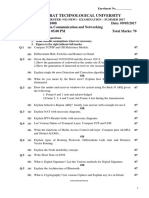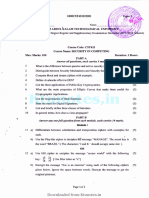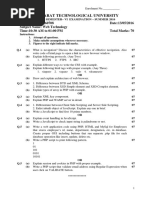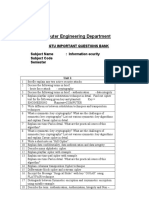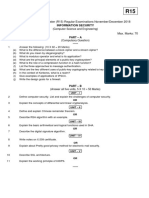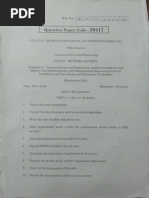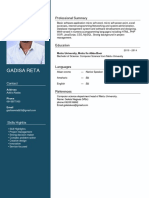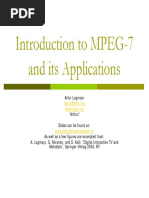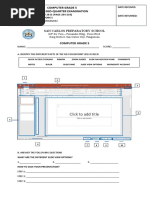0 ratings0% found this document useful (0 votes)
22 viewsGujarat Technological University
Gujarat Technological University
Uploaded by
parthThis document is an exam for the subject of Information and Network Security. It contains 5 questions assessing knowledge of topics like symmetric and asymmetric key cryptography algorithms, hashing, digital signatures, SSL, Kerberos, PKI, and types of cryptographic attacks. The exam has a total of 70 marks and instructs students to attempt all questions, make assumptions where necessary, and includes figures indicating the full marks for each subsection.
Copyright:
© All Rights Reserved
Available Formats
Download as PDF, TXT or read online from Scribd
Gujarat Technological University
Gujarat Technological University
Uploaded by
parth0 ratings0% found this document useful (0 votes)
22 views1 pageThis document is an exam for the subject of Information and Network Security. It contains 5 questions assessing knowledge of topics like symmetric and asymmetric key cryptography algorithms, hashing, digital signatures, SSL, Kerberos, PKI, and types of cryptographic attacks. The exam has a total of 70 marks and instructs students to attempt all questions, make assumptions where necessary, and includes figures indicating the full marks for each subsection.
Original Title
171611-2170709-INS
Copyright
© © All Rights Reserved
Available Formats
PDF, TXT or read online from Scribd
Share this document
Did you find this document useful?
Is this content inappropriate?
This document is an exam for the subject of Information and Network Security. It contains 5 questions assessing knowledge of topics like symmetric and asymmetric key cryptography algorithms, hashing, digital signatures, SSL, Kerberos, PKI, and types of cryptographic attacks. The exam has a total of 70 marks and instructs students to attempt all questions, make assumptions where necessary, and includes figures indicating the full marks for each subsection.
Copyright:
© All Rights Reserved
Available Formats
Download as PDF, TXT or read online from Scribd
Download as pdf or txt
0 ratings0% found this document useful (0 votes)
22 views1 pageGujarat Technological University
Gujarat Technological University
Uploaded by
parthThis document is an exam for the subject of Information and Network Security. It contains 5 questions assessing knowledge of topics like symmetric and asymmetric key cryptography algorithms, hashing, digital signatures, SSL, Kerberos, PKI, and types of cryptographic attacks. The exam has a total of 70 marks and instructs students to attempt all questions, make assumptions where necessary, and includes figures indicating the full marks for each subsection.
Copyright:
© All Rights Reserved
Available Formats
Download as PDF, TXT or read online from Scribd
Download as pdf or txt
You are on page 1of 1
Seat No.: ________ Enrolment No.
___________
GUJARAT TECHNOLOGICAL UNIVERSITY
BE - SEMESTER–VII(NEW) • EXAMINATION – WINTER 2016
Subject Code:2170709 Date:21/11/2016
Subject Name:Information and Network Security
Time:10.30 AM to 1.00 PM Total Marks: 70
Instructions:
1. Attempt all questions.
2. Make suitable assumptions wherever necessary.
3. Figures to the right indicate full marks.
Q.1 (a) What is symmetric key cryptography? What are the challenges of symmetric 07
key cryptography? List out various symmetric key algorithms and explain
Caesar cipher in detail.
(b) P and Q are two prime numbers. P=7, and Q=17. Take public key E=5. If plain 07
text value is 6, then what will be cipher text value according to RSA algorithm?
Explain in detail.
Q.2 (a) Explain one time Pad in detail. What are the practical issues of this algorithm? 07
(b) Explain Byte substitution and Shift row operation of AES in detail. 07
OR
(b) Explain DES key generation process in detail. 07
Q.3 (a) What is PKI? What are the components of PKI? Explain Certificate Authority 07
in detail.
(b) “Only Hashing dose not ensures integrity of message in network 07
communication” – Justify your answer with suitable example.
OR
Q.3 (a) Consider the scenario where user A wants to send bulk data (data is in GBs) to 07
user B using networking. Data exchange has to be done in confidential manner.
The key which is used for encryption can be intercepted by an attacker. Which
is the most efficient and protected way to achieve secure communication?
Justify your answer in detail.
(b) What is SSL? Which security services does it offers? How does it works? 07
Q.4 (a) What is Kerberos? How Kerberos authenticates the users for authorized service 07
access?
(b) Write a short note on “Digital Signature Algorithm”. 07
OR
Q.4 (a) Explain Diffie - Hellman key exchange algorithm 07
(b) Differentiate between hashing and encryption. What are the practical 07
applications of hashing? Compare MD5 and SHA1 hashing algorithms.
Q.5 (a) Write a short note on Message Authentication Code. 07
(b) Write a short note on:
i. Cipher text only attack 04
ii. Timing attack 03
OR
Q.5 (a) What is SSH? How does SSH works? 07
(b) Write a short note on “Hill Cipher”. 07
*************
You might also like
- 3m Usdt INVOICE - BTC USDT - SWAP 2023Document4 pages3m Usdt INVOICE - BTC USDT - SWAP 2023karmaeximglobal123100% (1)
- Gift Cards Method - Latest WOrkingDocument9 pagesGift Cards Method - Latest WOrkingtechnical deepuNo ratings yet
- University QuestionsDocument24 pagesUniversity QuestionsVasantha KumariNo ratings yet
- Creating Moodle Mobile Remote ThemesDocument13 pagesCreating Moodle Mobile Remote ThemesMNo ratings yet
- MC Users Guide 1.0 SIMS 4Document34 pagesMC Users Guide 1.0 SIMS 4mariohugoNo ratings yet
- Gujarat Technological UniversityDocument1 pageGujarat Technological UniversityShweta JhaNo ratings yet
- Gujarat Technological UniversityDocument1 pageGujarat Technological UniversityRahul SharmaNo ratings yet
- Gtu Computer 3170720 Winter 2022Document1 pageGtu Computer 3170720 Winter 2022Farhan MansuriNo ratings yet
- InsDocument2 pagesInsALL THINGS0% (1)
- Gujarat Technological University: InstructionsDocument2 pagesGujarat Technological University: InstructionsShweta JhaNo ratings yet
- Gujarat Technological UniversityDocument2 pagesGujarat Technological Universityneeraj sharmaNo ratings yet
- Summer 2013 PDFDocument1 pageSummer 2013 PDFShweta JhaNo ratings yet
- 3170720_merged (4)Document10 pages3170720_merged (4)kheevna1304No ratings yet
- IS GTU PaperDocument7 pagesIS GTU PaperAries GamingNo ratings yet
- Gujarat Technological UniversityDocument2 pagesGujarat Technological Universityhafaji8811No ratings yet
- IS MergedDocument10 pagesIS Mergedpainx2143No ratings yet
- Gujarat Technological UniversityDocument2 pagesGujarat Technological UniversityShweta JhaNo ratings yet
- Gujarat Technological UniversityDocument1 pageGujarat Technological Universitybubble-pork-depthNo ratings yet
- Gtu Computer 3170720 Summer 2022Document2 pagesGtu Computer 3170720 Summer 2022Farhan MansuriNo ratings yet
- Be Summer 2022Document2 pagesBe Summer 2022Jenish LathiyaNo ratings yet
- Instructions:: Gujarat Technological UniversityDocument1 pageInstructions:: Gujarat Technological UniversityShweta JhaNo ratings yet
- CNS W2023-3161606Document2 pagesCNS W2023-3161606Archi JariwalaNo ratings yet
- GTU SEM7 PapercombineDocument10 pagesGTU SEM7 Papercombinevedikab25No ratings yet
- Information Cyber Security Summer 2018Document2 pagesInformation Cyber Security Summer 2018minaparveennNo ratings yet
- Gujarat Technological UniversityDocument2 pagesGujarat Technological UniversityShweta JhaNo ratings yet
- Cryptography and System Security - May 2019 MUDocument1 pageCryptography and System Security - May 2019 MUFaraazNo ratings yet
- Gujarat Technological UniversityDocument2 pagesGujarat Technological Universityvedantdeshmukh340No ratings yet
- CNS S2023-3161606Document2 pagesCNS S2023-3161606Archi JariwalaNo ratings yet
- Gujarat Technological UniversityDocument1 pageGujarat Technological Universityyicef37689No ratings yet
- Gujarat Technological UniversityDocument3 pagesGujarat Technological Universitymalaviyaurvashi39No ratings yet
- Gujarat Technological University: What Is Cybersecurity?Document1 pageGujarat Technological University: What Is Cybersecurity?malaviyaurvashi39No ratings yet
- Cs 703 A Cryptography and Information Security Dec 2020Document2 pagesCs 703 A Cryptography and Information Security Dec 2020RahulNo ratings yet
- Gujarat Technological University: InstructionsDocument1 pageGujarat Technological University: InstructionsRockey SharmaNo ratings yet
- Gujarat Technological UniversityDocument1 pageGujarat Technological UniversityvehotiwuNo ratings yet
- (CS6701 PTCS6701)Document3 pages(CS6701 PTCS6701)Russian CarxgameNo ratings yet
- CST433 Security in Computing, December 2023Document2 pagesCST433 Security in Computing, December 2023anzilrashe2002No ratings yet
- SEIT3062 - Ravirajsinh ChauhanDocument2 pagesSEIT3062 - Ravirajsinh ChauhanYASH CHAHODIYANo ratings yet
- IS_AssignmentDocument3 pagesIS_Assignmentpiyush sadhuNo ratings yet
- Mcse 302 C Network Security Jun 2020Document2 pagesMcse 302 C Network Security Jun 2020harsh rimzaNo ratings yet
- Information Assurance & Network SecurityDocument2 pagesInformation Assurance & Network SecurityPayal AacharyaNo ratings yet
- Gujarat Technological UniversityDocument2 pagesGujarat Technological Universitythakornikita001.nt10No ratings yet
- CRYPTOGAPHYDocument4 pagesCRYPTOGAPHYVivek ShuklaNo ratings yet
- Gujarat Technological UniversityDocument1 pageGujarat Technological UniversityAnonymous Cc3oNYTLNo ratings yet
- Cst433 Security in Computing, May 2023Document2 pagesCst433 Security in Computing, May 2023nanduasbnNo ratings yet
- Cyber Secquerity 2023 QuestionDocument3 pagesCyber Secquerity 2023 Questionaank2itNo ratings yet
- 07a81903 InformationsecurityDocument6 pages07a81903 InformationsecuritySharanya ThirichinapalliNo ratings yet
- Gujarat Technological UniversityDocument1 pageGujarat Technological UniversityHardik PatoliyaNo ratings yet
- Computer Engineering Department: Gtu Important Questions Bank Subject Name: Information Ecurity Subject Code SemesterDocument5 pagesComputer Engineering Department: Gtu Important Questions Bank Subject Name: Information Ecurity Subject Code SemesterKaushal PardasaniNo ratings yet
- Cryptography and Network Security Feb 2020Document1 pageCryptography and Network Security Feb 2020Akshita dammuNo ratings yet
- Cryptography Quest Bank 02Document7 pagesCryptography Quest Bank 02Gurpreet SinghNo ratings yet
- MCA-505 (E) : M.C.A. V Semester Network SecurityDocument2 pagesMCA-505 (E) : M.C.A. V Semester Network Securityabhinavgiri17No ratings yet
- B.Tech IV Year I Semester (R15) Regular Examinations November/December 2018Document5 pagesB.Tech IV Year I Semester (R15) Regular Examinations November/December 2018pruthviNo ratings yet
- Network Security QPDocument2 pagesNetwork Security QPhell hackerNo ratings yet
- Gujarat Technological UniversityDocument5 pagesGujarat Technological Universityharshchauhan70166No ratings yet
- Subject Code-3507: Roll No. ....................... Exam Code: S-20Document2 pagesSubject Code-3507: Roll No. ....................... Exam Code: S-20Ashish SharmaNo ratings yet
- (WWW - Entrance-Exam - Net) - Download DOEACC C Level Network Security & Cryptography Sample Paper 1Document2 pages(WWW - Entrance-Exam - Net) - Download DOEACC C Level Network Security & Cryptography Sample Paper 1Mukesh BhambhaniNo ratings yet
- 136AW122019Document2 pages136AW122019Uma MaheshNo ratings yet
- 15A05702 Information SecurityDocument1 page15A05702 Information SecurityBilal AhmedNo ratings yet
- iVvTesXmTyGkgjFEXsaITQ - CM2025 Past Exam Mar 2023Document5 pagesiVvTesXmTyGkgjFEXsaITQ - CM2025 Past Exam Mar 2023chaudhary.ahmadNo ratings yet
- Directional CouplerDocument1 pageDirectional CouplerMRINAAL GOSAINNo ratings yet
- TE - SemVI - Cryptography - System SecurityDocument4 pagesTE - SemVI - Cryptography - System SecuritySURABHI NAIK192074No ratings yet
- Is 2007Document1 pageIs 2007nikita_07036880No ratings yet
- (WWW - Entrance-Exam - Net) - Download DOEACC C Level Network Security & Cryptography Sample Paper 2Document2 pages(WWW - Entrance-Exam - Net) - Download DOEACC C Level Network Security & Cryptography Sample Paper 2DEBLEENA VIJAYNo ratings yet
- CISA EXAM-Testing Concept-Digital SignatureFrom EverandCISA EXAM-Testing Concept-Digital SignatureRating: 3.5 out of 5 stars3.5/5 (5)
- ان القوم اسفرنس PDF 7Document2 pagesان القوم اسفرنس PDF 7princerash556677No ratings yet
- Gadisa Reta CVDocument1 pageGadisa Reta CVGadisa RetaNo ratings yet
- MNGT 1710Document10 pagesMNGT 1710snes19xxNo ratings yet
- 2000 Mini Cooper 1275 Workshop ManualDocument356 pages2000 Mini Cooper 1275 Workshop Manualtitosgarage65No ratings yet
- 1 About This Manual: 1.1 PurposeDocument1 page1 About This Manual: 1.1 PurposeSatyasrinivas PulavarthiNo ratings yet
- Cyber SecurityDocument21 pagesCyber SecurityzydjadelongnoNo ratings yet
- Tripleplay Interactive IPTV Portal For HealthcareDocument2 pagesTripleplay Interactive IPTV Portal For HealthcareMohamed ElessailyNo ratings yet
- Progressive Web AppDocument5 pagesProgressive Web AppTesfahun MegezeNo ratings yet
- Thesis FirewallDocument5 pagesThesis FirewallWriteMyPaperForCheapLittleRock100% (2)
- Minute MedDocument183 pagesMinute Medsopovskaya1No ratings yet
- Samsung SW-Competency Test: Samsung R&D BangaloreDocument10 pagesSamsung SW-Competency Test: Samsung R&D BangalorePradyumnakedilayNo ratings yet
- Internet of VehiclesDocument16 pagesInternet of VehiclesNarendran narendranNo ratings yet
- Introduction To MPEG-7 and Its ApplicationsDocument44 pagesIntroduction To MPEG-7 and Its ApplicationsAland MediaNo ratings yet
- Purposive Communication Module 2Document14 pagesPurposive Communication Module 2Rafaela OngNo ratings yet
- Supported UME Changes: Local DB To ABAP Server: Æ ÆSAP Release 640 and 700Document2 pagesSupported UME Changes: Local DB To ABAP Server: Æ ÆSAP Release 640 and 700loroowNo ratings yet
- Third Mid Quarter Exam For Computer Grade 5,7,8,9,10Document6 pagesThird Mid Quarter Exam For Computer Grade 5,7,8,9,10Fernandez JainardNo ratings yet
- Theory Questions RevisedDocument5 pagesTheory Questions RevisedMustafa PlaysNo ratings yet
- NetBackup1011 AdminGuide VMwareDocument381 pagesNetBackup1011 AdminGuide VMwareMJNo ratings yet
- 2022 03 02 Computeractive - Sanet.stDocument74 pages2022 03 02 Computeractive - Sanet.stshrikantNo ratings yet
- Patient Record Management App For DoctorsDocument11 pagesPatient Record Management App For DoctorsGaurav SharmaNo ratings yet
- Besom BillDocument1 pageBesom BillSubramanyam JonnaNo ratings yet
- LinkedIn Profile Best PracticesDocument4 pagesLinkedIn Profile Best Practicesshahbaz.sheikh.9No ratings yet
- Become A Leader by SlidesgoDocument39 pagesBecome A Leader by SlidesgoEstrella Grace BuenaventuraNo ratings yet
- Tayeb Souami - Google SearchDocument1 pageTayeb Souami - Google SearchEgbo WisdomNo ratings yet
- Questions & Answers for m2Document8 pagesQuestions & Answers for m2youssefanwar800No ratings yet
- Presentation On IDS Using DSC ProductsDocument22 pagesPresentation On IDS Using DSC ProductsVC HouseNo ratings yet

































